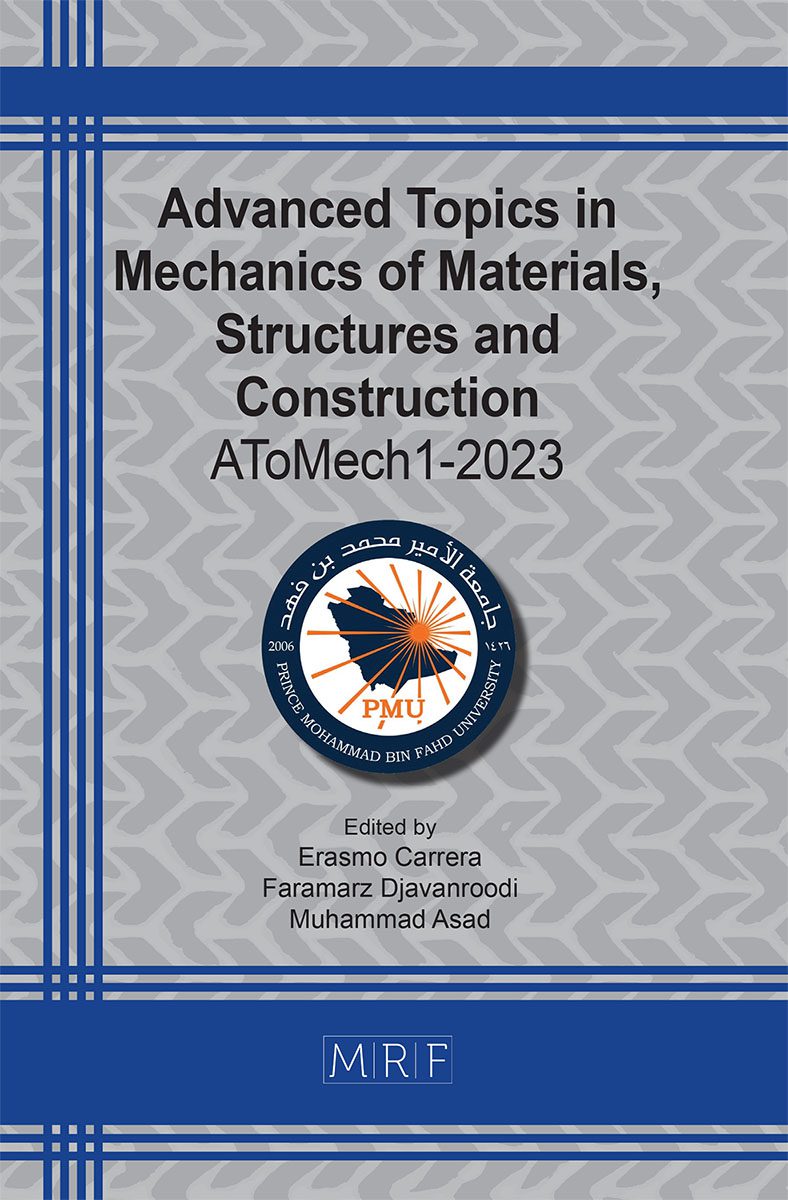Effect of steel fibres on the mechanical strengths of fly ash/GGBS based geopolymer concrete under ambient curing condition
Musa Adamu, Tejas D Doshi, Veerendrakumar C. Khed, Yasser E. Ibrahim
download PDFAbstract. The production of concrete involves the use of huge quantity of cement which is the main binder material. However, cement production involves the use of high amount of embodied energy and reduce of embodied CO2 emission. Hence one of the alternatives is the use of concrete with zero cement called geopolymer. However, the main shortcoming of geopolymer is its higher brittleness and low modulus of elasticity compared to conventional cement concrete. This led to the addition of fibres to geopolymer. In this study, the effect of steel fibres addition on the mechanical strengths of ambient cured geopolymer concrete was investigated. 60% Fly ash class F and 40% GGBFS are used as binder materials to produce ambient geopolymer concrete of grade 30 MPa, which was activated by alkaline solution (mixture of sodium Hydroxide and sodium silicate) with a constant Molarity of Sodium Hydroxide as 10M without any cement. End hooked steel fibres of aspect ratio 35, were added to the geopolymer at 0%, 0.25% and 0.5% by volume fraction. The results findings showed that the workability of the geopolymer decreased with increase in addition of steel fibres. Ambient cured specimens yield good results and higher strength is observed due to high polymerization process. Furthermore, the compressive, split tensile and flexural strengths all improved significantly with increase in percentage of volume of steel fibres at any ambient curing period.
Keywords
Geopolymer Concrete, Fly Ash, Ground Granulated Blast Furnace Slag, Steel Fiber, Mechanical Strengths
Published online 8/10/2023, 10 pages
Copyright © 2023 by the author(s)
Published under license by Materials Research Forum LLC., Millersville PA, USA
Citation: Musa Adamu, Tejas D Doshi, Veerendrakumar C. Khed, Yasser E. Ibrahim, Effect of steel fibres on the mechanical strengths of fly ash/GGBS based geopolymer concrete under ambient curing condition, Materials Research Proceedings, Vol. 31, pp 398-407, 2023
DOI: https://doi.org/10.21741/9781644902592-41
The article was published as article 41 of the book Advanced Topics in Mechanics of Materials, Structures and Construction
![]() Content from this work may be used under the terms of the Creative Commons Attribution 3.0 license. Any further distribution of this work must maintain attribution to the author(s) and the title of the work, journal citation and DOI.
Content from this work may be used under the terms of the Creative Commons Attribution 3.0 license. Any further distribution of this work must maintain attribution to the author(s) and the title of the work, journal citation and DOI.
References
[1] A. Bouaissi, L.-y. Li, M. M. A. B. Abdullah, Q.-B. Bui, Mechanical properties and microstructure analysis of FA-GGBS-HMNS based geopolymer concrete, Constr. Build. Mater, 210 (2019) 198-209. https://doi.org/10.1016/j.conbuildmat.2019.03.202
[2] V. Malhotra, Introduction: sustainable development and concrete technology, Concr. Int. 24 (2022), no. 7.
[3] J. Davidovits, Geopolymers and geopolymeric materials, J. therm. Anal. 35 (1989) 429-441 https://doi.org/10.1007/BF01904446
[4] J. Davidovits, Properties of geopolymer cements,” in First international conference on alkaline cements and concretes, 1 (1994) 131-149.
[5] Y. Ding, Y.-L. Bai, Fracture properties and softening curves of steel fiber-reinforced slag-based geopolymer mortar and concrete, Mater. 11-8 (2018), 1445. https://doi.org/10.3390/ma11081445.
[6] IS 3812 Part 1, Pulverized Fuel Ash Specification, New Delhi, India, (2013).
[7] IS 16714, Ground Granulated Blast Furnace Slag for Use in Cement, Mortar and Concrete – Specifications, New Delhi, India, (2018).
[8] A. Rafeet, R. Vinai, M. Soutsos, W. Sha, Guidelines for mix proportioning of fly ash/GGBS based alkali activated concretes, Constr. Build. Mater 147(2017) 130-142. https://doi.org/10.1016/j.conbuildmat.2017.04.036
[9] A. C. Ganesh, K. Sowmiya, M. Muthukannan, Investigation on the effect of steel fibers in geopolymer concrete, in IOP Conference Series: Materials Science and Engineering 872-1 (2020) 012156. https://doi.org/10.1088/1757-899X/872/1/012156
[10] Y. Liu, Z. Zhang, C. Shi, D. Zhu, N. Li, Y. Deng, Development of ultra-high performance geopolymer concrete (UHPGC): Influence of steel fiber on mechanical properties, Cem. Concr. Comp. 112 (2020) 103670. https://doi.org/10.1016/j.cemconcomp.2020.103670
[11] P. Zhang, J. Wang, Q. Li, J. Wan, Y. Ling, Mechanical and fracture properties of steel fiber-reinforced geopolymer concrete, Sci. Eng. Comp. Mater. 28-1(2021) 299-313. https://doi.org/10.1515/secm-2021-0030
[12] K. H. Mo, K. H. Yeoh, I. I. Bashar, U. J. Alengaram, M. Z. Jumaat, Shear behaviour and mechanical properties of steel fibre-reinforced cement-based and geopolymer oil palm shell lightweight aggregate concrete, Constr. Build. Mater. 148(2017) 369-375. https://doi.org/10.1016/j.conbuildmat.2017.05.017.
[13] G. L. Golewski, Changes in the fracture toughness under mode II loading of low calcium fly ash (LCFA) concrete depending on ages, Mater. 13-22 5241. https://doi.org/10.3390/ma13225241































